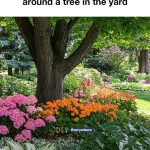ADVERTISEMENT
Materials You Can Repurpose for Garden Projects
There are many materials you can repurpose for garden projects, including wooden pallets, old windows, leftover bricks, and even household items like buckets and cribs. These materials are often readily available and can be obtained for free or at a low cost. Wooden pallets, for example, are versatile and can be used to create planters, compost bins, and even garden furniture. Old windows can be transformed into a charming greenhouse, while bricks can be used to build pathways or borders. By using repurposed materials, you not only save money but also contribute to a more sustainable environment.
1. Creating Bucket Towers for Vertical Gardening

Bucket towers are an excellent solution for small spaces or urban gardens. To create a bucket tower, start by gathering several buckets or large containers. Drill drainage holes in the bottom of each bucket. Stack the buckets vertically, securing them with a sturdy pole or rod through the center. Fill each bucket with soil and plant your favorite herbs or flowers. This vertical garden structure maximizes space and can be easily moved or rearranged as needed.
2. Transforming Old Cribs into Trellises

Old cribs can be repurposed into trellises for climbing plants such as peas, beans, or cucumbers. Remove one side of the crib to create a flat trellis. Secure the crib frame into the ground or against a wall using stakes or brackets. The slats of the crib provide perfect support for climbing plants, and the structure adds a whimsical touch to your garden. This project not only saves an old crib from the landfill but also provides a functional and attractive garden feature.
3. Building Pallet Planters for Versatile Planting

Pallet planters are a versatile and easy-to-make garden structure. Start by selecting a wooden pallet in good condition. Sand down any rough edges to prevent splinters. You can use the pallet as is, or disassemble it to create custom-sized planters. Line the inside with landscape fabric to hold the soil in place, and fill with your choice of plants. Pallet planters can be placed on the ground or mounted vertically on a wall or fence, making them ideal for small spaces.
4. Crafting Rustic Twig Arbors for Climbing Plants

Twig arbors add a rustic charm to any garden and are perfect for supporting climbing plants like roses or clematis. To create a twig arbor, gather sturdy branches and twigs from your yard or a nearby wooded area. Use twine or wire to secure the branches together, forming an arch. Anchor the ends of the arbor into the ground for stability. This natural structure blends seamlessly into the garden and provides a beautiful focal point.
5. Designing Simple Raised Beds with Reclaimed Wood

Raised beds are a great way to improve drainage and soil quality in your garden. To build a raised bed, use reclaimed wood such as old fence panels or pallets. Cut the wood to your desired size and shape, and assemble the pieces using screws or nails. Line the bottom with landscape fabric to prevent weeds, and fill with a mix of soil and compost. Raised beds are easy to maintain and can be customized to fit any garden space.
6. Constructing a Garden Bench from Salvaged Materials

A garden bench provides a place to relax and enjoy your outdoor space. To build a bench, gather salvaged materials such as old wooden beams, planks, or even bricks. Design a simple bench by stacking bricks for the legs and using a sturdy plank for the seat. Alternatively, use wooden beams to create a more traditional bench design. Sand and seal the wood to protect it from the elements. This project is not only practical but also adds a personal touch to your garden.
7. Making a Compost Bin with Wooden Pallets
Composting is an excellent way to recycle kitchen and garden waste into nutrient-rich soil. To make a compost bin, use three or four wooden pallets. Stand the pallets upright to form a square or rectangle, securing them together with screws or wire. Leave one side open or attach it with hinges for easy access. This simple structure allows for good air circulation and makes turning the compost easy. A pallet compost bin is an eco-friendly addition to any garden.
8. Assembling a Greenhouse from Recycled Windows

A greenhouse extends your growing season and protects plants from harsh weather. To build a greenhouse, collect old windows from renovation projects or salvage yards. Arrange the windows to form the walls and roof of the greenhouse, securing them with brackets or hinges. Use additional wood or metal for the frame if needed. Ensure there is adequate ventilation by incorporating opening windows or vents. This charming greenhouse not only provides a functional growing space but also adds character to your garden.
9. Designing a Birdhouse from Leftover Lumber

Birdhouses attract beneficial wildlife to your garden and can be made from leftover lumber. Cut the wood into pieces to form the walls, roof, and base of the birdhouse. Assemble the pieces using nails or screws, and drill a small entrance hole. Add a perch below the entrance if desired. Paint or decorate the birdhouse to match your garden’s theme. Hang the birdhouse in a tree or on a post, and enjoy watching the birds that come to visit.
10. Building a Garden Pathway with Recycled Bricks
A brick pathway adds structure and charm to your garden. To create a pathway, gather recycled bricks from construction sites or demolition projects. Clear and level the area where the path will go, and lay the bricks in your desired pattern, such as herringbone or basket weave. Fill the gaps between the bricks with sand or gravel to secure them in place. A brick pathway is durable, easy to maintain, and provides a classic look to any garden.
Conclusion: The Joy of DIY Garden Projects
DIY garden projects offer a unique opportunity to express creativity while enhancing your outdoor space. By using repurposed materials, you can create beautiful and functional garden structures without spending a fortune. These projects not only improve the aesthetics of your garden but also provide a sense of satisfaction and accomplishment. Whether you’re building a simple planter or an elaborate greenhouse, the process of creating something with your own hands is rewarding and enjoyable. Embrace the joy of DIY gardening and transform your garden into a personal oasis.


